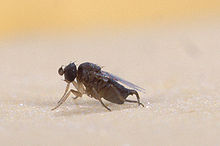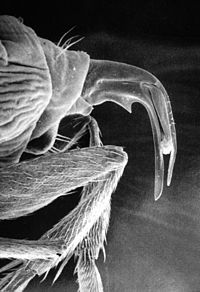- Phoridae
-
Phoridae 
Pseudacteon sp., showing the humped back that is characteristic of the family Scientific classification Kingdom: Animalia Phylum: Arthropoda Subphylum: Hexapoda Class: Insecta Order: Diptera Suborder: Brachycera Infraorder: Muscomorpha Section: Aschiza Superfamily: Platypezoidea Family: Phoridae Subfamilies - Aenigmatiinae
- Metopininae
- Phorinae
- Sciadocerinae
Phoridae is a family of small, hump-backed flies resembling fruit flies. Phorid flies can often be identified by their escape habit of running rapidly across a surface rather than taking to the wing. This behaviour is a source of one of their alternate names: scuttle fly. They are a diverse and successful group of insects. Approximately 4,000 species are known in 230 genera. The most well-known species is Megaselia scalaris, commonly called a "coffin fly".
Contents
Appearance
Phorid flies are about 1⁄64–1⁄4 in (½–6 mm) in length. When viewed from the side, there is a pronounced hump to the thorax.[1] The colour ranges from black or brown to yellowish.They have a characteristic wing venation.
Classification
Traditionally, phorids were classified into six subfamilies: Phorinae, Aenigmatiinae, Metopininae (including tribes Beckerinini and Metopinini), Alamirinae, Termitoxeniinae, and Thaumatoxeninae. Disney & Cumming (1992 [1]) abolished Alamirinae when they showed that they were the 'missing' males of Termitoxeniinae, which were known only from females.
Also in 1992, Brown[2] presented a revised, cladistic classification based on many new character states. This classification included subfamilies Hypocerinae, Phorinae, Aenigmatiinae, Conicerinae, and Metopininae (Termitoxeniinae and Thaumatoxeninae were not included in his study). Disney rejected the entirety of Brown's work, deeming it premature, and a lively debate ensued[3][4][5] Further resolution of this controversy awaits new data.
Environment
Phorid flies are found worldwide, though the greatest variety of species is to be found in the tropics. They are frequently found around flowers and moist decaying matter, although they can be found throughout the house. Several species have the common name of the coffin fly, because they breed in human corpses with such tenacity that they can even continue their life cycle within buried coffins. For this reason they are important in forensic entomology. More generally, the larvae breed in a numerous variety of locations, such as dung, fungi, decaying plant matter or drain pipes. Most commonly they feed on decaying organic matter. Because they frequent unsanitary places they may transport various disease-causing organisms to food material.
Life cycle
Phorid flies develop from an egg, and via larval, and pupal stages before emerging as an adult. The female lays from 1 to 100 tiny eggs at a time in or on the larval food. She can lay up to 750 eggs in her lifetime. The time it takes from egg to adult varies on the species, but the average is about 25 days.
The larvae emerge in 24 hours and feed for a period of between 8 and 16 days, before crawling to a drier spot to pupate. The phorid fly's egg-to-adult life cycle can be as short as 14 days but may take up to 37 days.
Many species of phorid fly are specialist parasitoids of ants, but there are also species in the tropics that are parasitoids of stingless bees. These affected bees are often host to more than one fly larva and some individuals have been found to contain 12 phorid larva.[6]
Control of fire ants
Phorid flies also represent a new and hopeful means by which to control fire ant populations in the southern United States, where fire ants were accidentally introduced in the 1930s. The genus Pseudacteon, or ant-decapitating fly, of which 110 species have been documented, is a parasitoid of the ant in South America. Members of Pseudacteon reproduce by laying eggs in the thorax of the ant. The first instar larvae migrate to the head. The larvae develop by feeding on the hemolymph, muscle tissue, and nervous tissue in the head. Eventually, the larvae completely devour the ant's brain, causing it to do nothing but wander aimlessly for approximately two weeks.[7] After about two[8] to four[7] weeks, they cause the ant's head to fall off by releasing an enzyme that dissolves the membrane attaching the ant's head to its body. The fly pupates in the detached head capsule, requiring a further two weeks before emerging. Various species of Phoridae have been introduced throughout the U. S. Southeast, starting with Travis, Brazos, and Dallas counties in Texas, as well as Mobile, Alabama, where the ants first entered North America.[7][8]
Identification
Beyer, E.; Delage, A. Bearbeitet von: Schmitz, H. Phoridae 672 Seiten, 437 Abbildungen, 15 Tafeln, 26x19cm (in Erwin Lindner: Die Fliegen der Paläarktischen Region, Band IV / 7 Teil 1)1981 ISBN 3-510-43023-9
Borgmeier, T. 1963. Revision of the North American phorid flies. Part I. The Phorinae, Aenigmatiinae, and Metopininae, except Megaselia (Diptera: Phoridae). Stud. Entomol. 6:1-256.Keys subfamilies, genera and species.
Other
There have been a few reports of phorid flies opportunistically causing human myiasis.[9][10]
References
- ^ Disney, R.H.L. & Cumming, M.S. (1992) Abolition of Alamirinae and ultimate rejection of Wasmann's theory of hermaphroditism in Termitoxeniinae (Diptera: Phoridae). Bonner zoologische Beiträge, 43, 145-154.
- ^ Brown, B.V. (1992) Generic revision of Phoridae of the Nearctic Region and phylogenetic classification of Phoridae, Sciadoceridae and Ironomyiidae (Diptera: Phoridea). Memoirs of the Entomological Society of Canada, 164, 1-144.
- ^ Disney, R.H.L. (1993) Mosaic evolution and outgroup comparisons. Journal of Natural History, 27, 1219-1221.
- ^ Brown, B.V. (1995) Response to Disney. Journal of Natural History, 29, 259-264.
- ^ Disney, R.H.L. (1995) Reply to Brown. Journal of Natural History, 29, 1081-1082.
- ^ Piper, Ross (2007), Extraordinary Animals: An Encyclopedia of Curious and Unusual Animals, Greenwood Press.
- ^ a b c Hanna, Bill (Tue May 12, 2:09 pm ET). "Parasitic flies turn fire ants into zombies". Fort Worth Star-Telegram. http://news.yahoo.com/s/mcclatchy/20090512/sc_mcclatchy/3231765. Retrieved 2009-05-14.[dead link]
- ^ a b "New weapon turns fire ants into headless zombies". San Francisco Chronicle. May 13, 2009. http://www.sfgate.com/cgi-bin/article.cgi?f=/n/a/2009/05/13/national/a062256D48.DTL&tsp=1. Retrieved May 13, 2009.[dead link]
- ^ T. L. Carpenter and D. O. Chastain: "Facultative Myiasis by Megaselia sp. (Diptera: Phoridae): A Case Report" in Journal of Medical Entomology, Vol. 29, No. 3 (1992), pp. 561-563.
- ^ K. Komori, K. Hara, K.G.V. Smith, T. Oda, D. Karamine: "A case of lung myiasis caused by larvae of Megaselia spiracularis Schmitz (Diptera: Phoridae)" in Transactions of the Royal Society of Tropical Medicine and Hygiene, Vol. 72 (1978), No. 5, pp. 467-470.
- Disney, R. H. L. (1994). Scuttle Flies: The Phoridae. London, Chapman & Hall. ISBN 0-412-56520-X.
- Disney, R. H. L. (2001) Sciadoceridae (Diptera) reconsidered. Fragmenta Faunistica 44: 309-317.
External links
- Entomology Section, Natural History Museum of Los Angeles County
- Family description and images
- Gallery from Diptera.info
- Taxonomy and ecofaunistic... In German (parts in English) Excellent illustrations.
- Pseudacteon species used in fire ant control on the UF / IFAS Featured Creatures Web site
- A discovery channel short, covering these flies
Species lists
Categories:- Flies
- Biological pest control agents
- Insect families
- Mind-altering parasites
Wikimedia Foundation. 2010.


